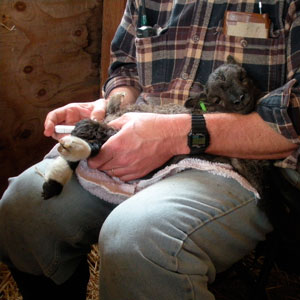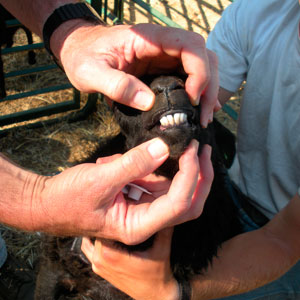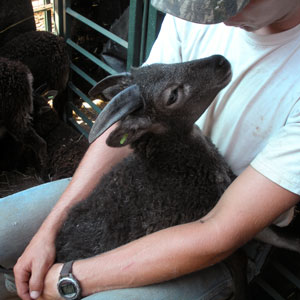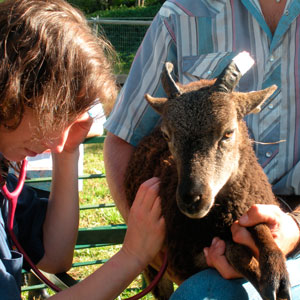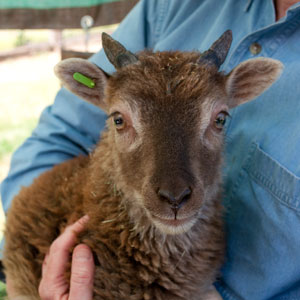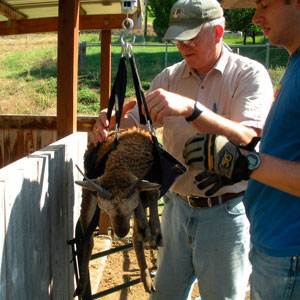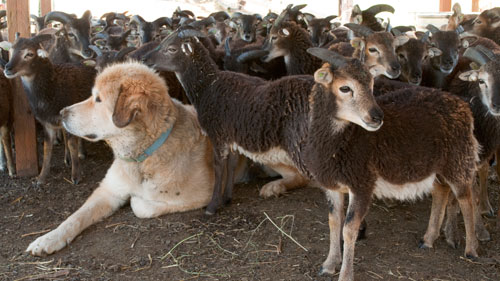 What do we mean when we speak of “Starter Flock”? The basic idea is
obvious, or course. But for us, there is much more to the idea of a starter flock than a
few ewes, a ram, perhaps a wether.
What do we mean when we speak of “Starter Flock”? The basic idea is
obvious, or course. But for us, there is much more to the idea of a starter flock than a
few ewes, a ram, perhaps a wether.
Each spring we oversee the production (the ewes handle the details) of a whole bunch of the most adorable, healthiest, RBST-registered Soay lambs you ever did see. But seriously now, it's not the cute lambs, or not just the cute lambs, that we will be sending out into the world. Rather, our role is to put together genetically sensible bundles of these lambs, each little sheep being a discrete package of genes, and each starter flock in turn a bundle of such packages. These furry gene packets go out in the world wide-eyed to breed and so to establish new colonies of authentic, registered Soay sheep around the continent, both in the U.S. and in Canada.
Raw Materials
Our Ewes
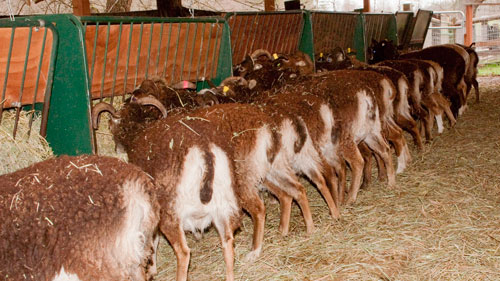 We maintain a breeding flock of about seventy British ewes, each
assigned to one of three bloodlines. Ewes within a bloodline are by and large more closely
related to each other than ewes from different bloodlines. The pasture farthest from our
ewes (for obvious reasons), the “bullpen” is home a whole bunch of rams. These
rams also belong to one of the same three bloodlines, just like the ewes. Each fall several
lucky rams, at least one from each bloodline, travel to a place called “Upper
Barnyard”, also known as our breeding pens. There each flocksire consorts for eight
to ten weeks with his assigned harem. Each bloodline provides one or two different breeding
groups of ewes, each with its own breeding ram. Here
is a link to more on how all this bloodline shuffling works.
We maintain a breeding flock of about seventy British ewes, each
assigned to one of three bloodlines. Ewes within a bloodline are by and large more closely
related to each other than ewes from different bloodlines. The pasture farthest from our
ewes (for obvious reasons), the “bullpen” is home a whole bunch of rams. These
rams also belong to one of the same three bloodlines, just like the ewes. Each fall several
lucky rams, at least one from each bloodline, travel to a place called “Upper
Barnyard”, also known as our breeding pens. There each flocksire consorts for eight
to ten weeks with his assigned harem. Each bloodline provides one or two different breeding
groups of ewes, each with its own breeding ram. Here
is a link to more on how all this bloodline shuffling works.
Our Rams
 Using several rams and breeding groups rather than just one or two rams gives us many more genetically
good choices when we sort the lamb crop in mid-summer into starter flocks for our
customers. If we get a reasonably good ewe/ram split during lambing, we can provide
starter flocks of up to six ewe lambs each sired by a different ram. That's our goal and
we usually make it — or close.
Using several rams and breeding groups rather than just one or two rams gives us many more genetically
good choices when we sort the lamb crop in mid-summer into starter flocks for our
customers. If we get a reasonably good ewe/ram split during lambing, we can provide
starter flocks of up to six ewe lambs each sired by a different ram. That's our goal and
we usually make it — or close.
Quality Control
We spend an embarrassingly large portion of our time each spring sitting in the lamb playyard admiring the ewes' handiwork and pointing out to each other the outstanding characteristics of each lamb as it comes whizzing by in a game of catch-me-if-you-can. On a more formal basis, we evaluate our lambs in detail at least four times, usually more: right after birth when we work each lamb; at about six weeks when they receive their first vaccination; again at ten weeks for their second shots; and when we wean them at about three months. At each of these more structured times we weigh the lambs and examine them to be sure they are gaining weight steadily. Do they have all their parts (teeth, testicles, etc)? Are there any signs of scouring? All of this attention means we catch and treat any problems early and then are able to send robust young Soay sheep off to their new homes. In addition, lambs going out of state receive a going-over by Dr. Rebecca or Dr. Jeanne before she issues their shipping papers. So, all in all, we are confident of their overall health.
Packaging: Putting starter flocks together

Assignment of specific ewe lambs (and rams) to starter flocks is driven first and foremost by considerations of genetic diversity. We sit down with all our orders and all our lambs and divide them up so that every customer gets as unrelated a group of animals as we can manage. Not surprisingly, each year we also receive specific requests: dark, light, spotted, no spotting, etc. We honor these whenever possible, but only if they fit within the fundamental goal of genetic diversity and genetic conservation. It depends on what lambs appear and the nature of any special requests, but usually we can figure out a way. As far as diversity is concerned, we almost always are able to meet or come close to our goal of providing ewe lambs who share no common parents with each other, and rams who have neither a common parent nor a common grandparent with any of the ewe lambs in that customer's order or with any British ewes the customer already has. It is this aspect of our operation — the ability to provide such diverse starter flocks — that Steve always brings up when Priscilla grouses about our flock being too big.
